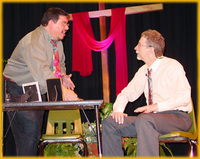 A bit of advice on using drama in worship, excerpted from a forthcoming publication.
A bit of advice on using drama in worship, excerpted from a forthcoming publication.
“We need more drama in worship. But drama of the right sort. Not a light-hearted warm-up to the sermon, not a subtlety-deficient morality lesson – a good hard thwack in the ethics – but something that does what drama does best: provoke and ask questions. We need drama that genuinely invites the congregation into a space where the text and our unique lives intersect.
“Of course, all congregations use drama in worship. Scripture read with passion and intelligence is drama. A song that tells the salvation story is drama. Worship as a whole is drama. The best worship services, the best liturgies, are those that re-enact the drama of God and God’s people, traversing the contours of the covenant life. For that very reason, other “mini” dramas, inserted into the liturgy, can distract from the primary work of the people. Yet thoughtful, well-written drama can be used fruitfully in worship: to point out paradox or hypocrisy, to deepen confession, to give expression to anguish, to testify to unmerited grace. It can illumine places where the changeless Gospel intersects with our changing times. In a world becoming less literate and more oral and aural, drama is a powerful – and often overlooked – tool for proclaiming that Gospel.
“Still, the wise pastor will make sure that materials used in worship are reviewed by someone with theological discernment, who knows a good heresy when she sees one, who knows to avoid moralistic shlock and propagandistic screeds, who shuns the quick laugh and uninformed improvisation; someone who knows that part of the power of drama in worship is its poetic character, the concentrated, careful use of words – always in service of the One Word.”Continue reading...










